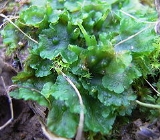
Hornwort
Overview
Hornworts are a group of bryophyte
s, or non-vascular plant
s, comprising the division Anthocerotophyta. The common name refers to the elongated horn-like structure, which is the sporophyte
. The flattened, green plant body of a hornwort is the gametophyte
plant.
Hornworts may be found worldwide, though they tend to grow only in places that are damp or humid. Some species grow in large numbers as tiny weeds in the soil of gardens and cultivated fields.
Bryophyte
Bryophyte is a traditional name used to refer to all embryophytes that do not have true vascular tissue and are therefore called 'non-vascular plants'. Some bryophytes do have specialized tissues for the transport of water; however since these do not contain lignin, they are not considered to be...
s, or non-vascular plant
Non-vascular plant
Non-vascular plants is a general term for those plants without a vascular system . Although non-vascular plants lack these particular tissues, a number of non-vascular plants possess tissues specialized for internal transport of water....
s, comprising the division Anthocerotophyta. The common name refers to the elongated horn-like structure, which is the sporophyte
Sporophyte
All land plants, and some algae, have life cycles in which a haploid gametophyte generation alternates with a diploid sporophyte, the generation of a plant or algae that has a double set of chromosomes. A multicellular sporophyte generation or phase is present in the life cycle of all land plants...
. The flattened, green plant body of a hornwort is the gametophyte
Gametophyte
A gametophyte is the haploid, multicellular phase of plants and algae that undergo alternation of generations, with each of its cells containing only a single set of chromosomes....
plant.
Hornworts may be found worldwide, though they tend to grow only in places that are damp or humid. Some species grow in large numbers as tiny weeds in the soil of gardens and cultivated fields.

